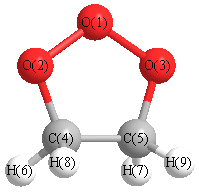Vibrational Frequencies calculated at CCD/aug-cc-pVDZ
| Mode Number |
Symmetry |
Frequency
(cm-1) |
Scaled Frequency
(cm-1) |
IR Intensities
(km mol-1) |
Raman Act
(Å4/u) |
Dep P |
Dep U |
|---|
| 1 |
A' |
3170 |
3058 |
25.82 |
|
|
|
| 2 |
A' |
3091 |
2981 |
46.85 |
|
|
|
| 3 |
A' |
1523 |
1469 |
0.16 |
|
|
|
| 4 |
A' |
1361 |
1313 |
0.02 |
|
|
|
| 5 |
A' |
1248 |
1204 |
2.75 |
|
|
|
| 6 |
A' |
1047 |
1009 |
31.85 |
|
|
|
| 7 |
A' |
966 |
932 |
14.52 |
|
|
|
| 8 |
A' |
930 |
897 |
3.56 |
|
|
|
| 9 |
A' |
866 |
835 |
0.56 |
|
|
|
| 10 |
A' |
721 |
695 |
1.74 |
|
|
|
| 11 |
A' |
414 |
399 |
4.00 |
|
|
|
| 12 |
A" |
3151 |
3039 |
0.44 |
|
|
|
| 13 |
A" |
3079 |
2970 |
18.46 |
|
|
|
| 14 |
A" |
1504 |
1451 |
0.68 |
|
|
|
| 15 |
A" |
1358 |
1310 |
0.54 |
|
|
|
| 16 |
A" |
1234 |
1191 |
0.00 |
|
|
|
| 17 |
A" |
1160 |
1118 |
0.13 |
|
|
|
| 18 |
A" |
1049 |
1012 |
1.79 |
|
|
|
| 19 |
A" |
811 |
782 |
28.85 |
|
|
|
| 20 |
A" |
738 |
712 |
3.96 |
|
|
|
| 21 |
A" |
126 |
121 |
2.80 |
|
|
|
Unscaled Zero Point Vibrational Energy (zpe) 14772.4 cm
-1
Scaled (by 0.9645) Zero Point Vibrational Energy (zpe) 14247.9 cm
-1
See section
III.C.1 List or set vibrational scaling factors
to change the scale factors used here.
See section
III.C.2
Calculate a vibrational scaling factor for a given set of molecules
to determine the least squares best scaling factor.
